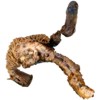Three Cases of Concomitant Intraductal Papillary Mucinous Neoplasm and Pancreatic Neuroendocrine Tumour
Abstract
Context Intraductal papillary mucinous neoplasms (IPMNs) are uncommon tumours which can be associated with pancreatic and extrapancreatic malignancies. The association of IPMN and neuroendocrine tumours of the pancreas has been reported previously but is exceedingly rare. Case report We report three cases of IPMN treated with total pancreatectomy/extended distal pancreatectomy. Histopathological analysis of the resected specimens revealed concomitant IPMN and neuroendocrine tumour. Two patients had adenocarcinoma as well. Conclusions The presence of an IPMN may place the entire pancreas at risk of developing other tumour types and vigilance during all stages of management is necessary to ensure optimal treatment.
Image: Total pancreatectomy and cholecystectomy.
Downloads
References
Adsay NV, Conlon KC, Zee SY, Brennan MF, Klimstra DS: Intraductal papillary-mucinous neoplasms of the pancreas: an analysis of in situ and invasive carcinomas in 28 patients. Cancer 2002, 94(1):62-77.
Calculli L, Pezzilli R, Brindisi C, Morabito R, Casadei R, Zompatori M: Pancreatic and extrapancreatic lesions in patients with intraductal papillary mucinous neoplasms of the pancreas: a single-centre experience. Radiol Med 2010, 115(3):442-452.
Tanaka M, Fernandez-del Castillo C, Adsay V, Chari S, Falconi M, Jang JY, Kimura W, Levy P, Pitman MB, Schmidt CM et al: International consensus guidelines 2012 for the management of IPMN and MCN of the pancreas. Pancreatology 2012, 12(3):183-197.
Shi C, Hruban RH: Intraductal papillary mucinous neoplasm. Hum Pathol 2012, 43(1):1-16.
Schnelldorfer T, Sarr MG, Nagorney DM, Zhang L, Smyrk TC, Qin R, Chari ST, Farnell MB: Experience with 208 resections for intraductal papillary mucinous neoplasm of the pancreas. Arch Surg 2008, 143(7):639-646; discussion 646.
Ohtsuka T, Kono H, Tanabe R, Nagayoshi Y, Mori Y, Sadakari Y, Takahata S, Oda Y, Aishima S, Igarashi H et al: Follow-up study after resection of intraductal papillary mucinous neoplasm of the pancreas; special references to the multifocal lesions and development of ductal carcinoma in the remnant pancreas. Am J Surg 2012, 204(1):44-48.
Heidt DG, Burant C, Simeone DM: Total pancreatectomy: indications, operative technique, and postoperative sequelae. J Gastrointest Surg 2007, 11(2):209-216.
Geller SA, Dhall D, Alsabeh R: Application of immunohistochemistry to liver and gastrointestinal neoplasms: liver, stomach, colon, and pancreas. Arch Pathol Lab Med 2008, 132(3):490-499.
Wu J, Matthaei H, Maitra A, Dal Molin M, Wood LD, Eshleman JR, Goggins M, Canto MI, Schulick RD, Edil BH et al: Recurrent GNAS mutations define an unexpected pathway for pancreatic cyst development. Sci Transl Med 2011, 3(92):92ra66.
Strosberg JR, Nasir A, Hodul P, Kvols L: Biology and treatment of metastatic gastrointestinal neuroendocrine tumors. Gastrointest Cancer Res 2008, 2(3):113-125.
Ishida M, Shiomi H, Naka S, Tani T, Okabe H: Concomitant intraductal papillary mucinous neoplasm and neuroendocrine tumor of the pancreas. Oncol Lett 2013, 5(1):63-67.
Goh BK, Ooi LL, Kumarasinghe MP, Tan YM, Cheow PC, Chow PK, Chung YF, Wong WK: Clinicopathological features of patients with concomitant intraductal papillary mucinous neoplasm of the pancreas and pancreatic endocrine neoplasm. Pancreatology 2006, 6(6):520-526.
Marrache F, Cazals-Hatem D, Kianmanesh R, Palazzo L, Couvelard A, O'Toole D, Maire F, Hammel P, Levy P, Sauvanet A et al: Endocrine tumor and intraductal papillary mucinous neoplasm of the pancreas: a fortuitous association? Pancreas 2005, 31(1):79-83.
Gill KR, Scimeca D, Stauffer J, Krishna M, Woodward TA, Jamil LH, Wallace MB, Nguyen JH, Raimondo M: Pancreatic neuroendocrine tumors among patients with intraductal papillary mucinous neoplasms: real association or just a coincidence? JOP 2009, 10(5):515-517.

Copyright (c) 2014 Nilanjana Tewari, Abed M Zaitoun, Daniel Lindsay, Areeg Abbas, Mohammad Ilyas, Dileep N Lobo

This work is licensed under a Creative Commons Attribution 4.0 International License.
As a member of Publisher International Linking Association, PILA, iMedPub Group’s JOP follows the Creative Commons Attribution License and Scholars Open Access publishing policies. Journal of the Pancreas is the Council Contributor Member of Council of Science Editors (CSE) and following the CSE slogan Education, Ethics, and Evidence for Editors.